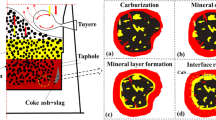Conclusions
A simple method, proposed for modelling the material, grading and chemical compositions of the hearths of open-hearth furnaces, permitted us to make comparative evaluations of the phase composition and structure of “hearths” in relation to the grading of the powder, the amount of sinter, the grain size of the dolomite, etc.
To obtain dense and high-temperature-resistant “hearths,” metallurgical powder should be used with a limited grain size (not more than 5–10 mm).
A favorable effect on the development of the “hearth” is had by the fine fraction of magnesite (below 0.1 mm) which helps to increase recrystallization of periclase in the bond part of the hearth.
The amount of sinter added to the magnesite powder should not exceed 35%, since more leads to a decomposition of the solid solutions of magnesioferrite in the periclase and weakening of recrystallization.
Together with the recrystallization of periclase in the coarse grains (pieces) recrystallization should be accomplished in the periclase of the bond part of the “hearth.”
Such a development in the process of recrystallization greatly helps densification of the “hearths.”
Titanomagnetite concentrate should be added in limited amounts and well distributed in the magnesite powder.
A high content of titanomagnetite concentrate or unsatisfactory distribution helps to develop easily fusible titanates in the bond part of the “hearth.”
Dolomite added to the magnesite powder can be profitably added in as fine a state as possible, since this helps more intense recrystallization of periclase and a reduction in the easily fusible ferritic interlayers between the crystals of periclase.
The investigation permits us to make the following important recommendations for the practice of fettling and ramming open-hearth furnaces:
use of a rational fine grain composition of magnesite powder with a maximum grain size of not more than 5–10 mm, the amount of the below-0.5 mm fraction 40–50% including not less than 15% finer than 0.1 mm;
limitation of the amount of added sinter and titanomagnetite concentrate and careful distribution of the latter;
the introduction of dolomite in the form of particles as fine as possible.
Similar content being viewed by others
Literature cited
V. A. Bron and L. B. Khoroshavin, “Stal',” No. 1 (1962).
V. A. Bron, L. B. Khoroshavin, O. Ya. Vainshtein, V. M. Medyakova, and M. G. Firsov, Trans. Vostok Institute of Refractories, No. 3 (1961).
A. V. Rudneva, Trans. Fifth Conference on Experimental and Technical Mineralogy and Petrography [in Russian] Izd. AN SSSR, 285 (1958).
V. A. Bron, A. L. Bogorodskii, and K. P. Semavina, Production of Stel. Collection of Articles [in Russian] Gos. Izd. Mashinostr. Literatury, 128 (1958).
Author information
Authors and Affiliations
Rights and permissions
About this article
Cite this article
Bron, V.A. Investigating the phase composition and structure of laboratory specimens duplicating compositions of open-hearth furnace bottoms. Refractories 4, 34–42 (1963). https://doi.org/10.1007/BF01283226
Issue Date:
DOI: https://doi.org/10.1007/BF01283226




